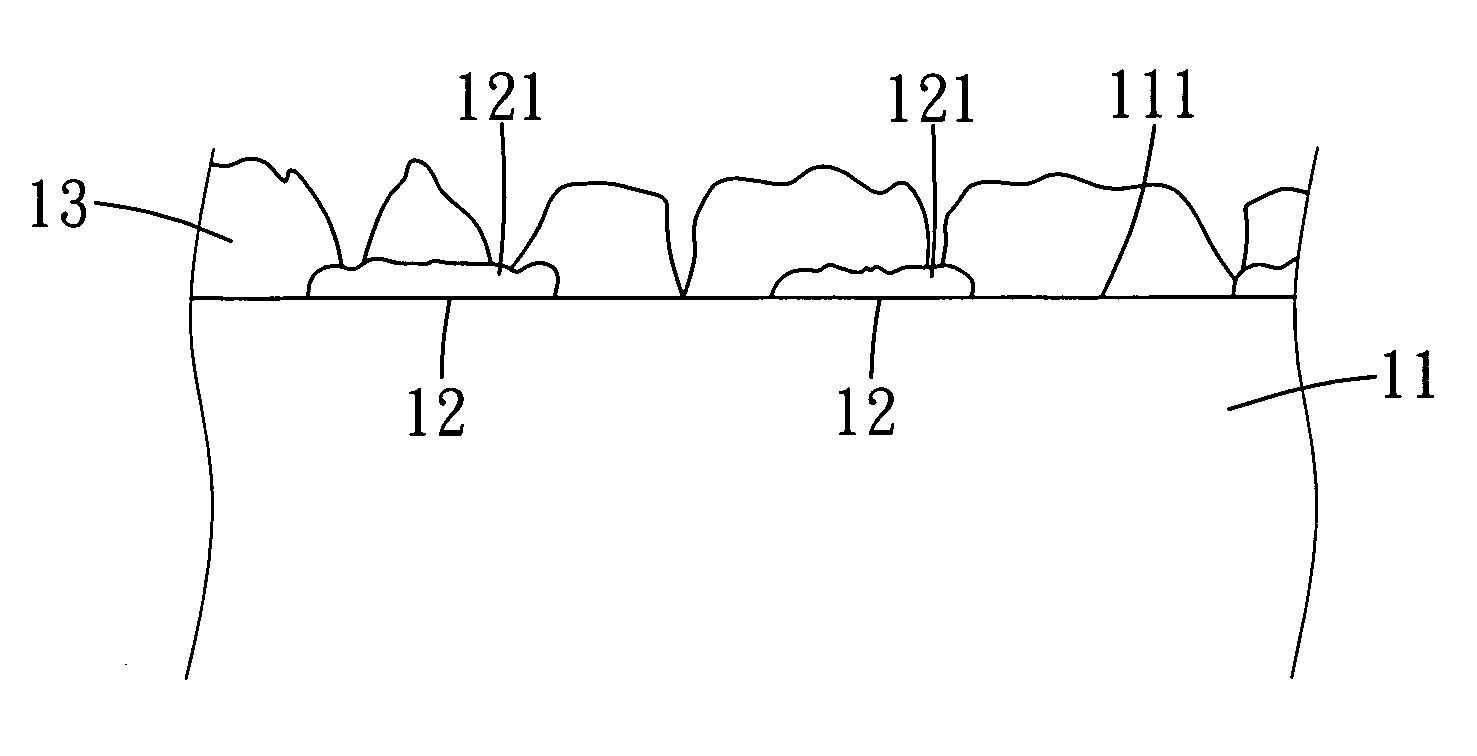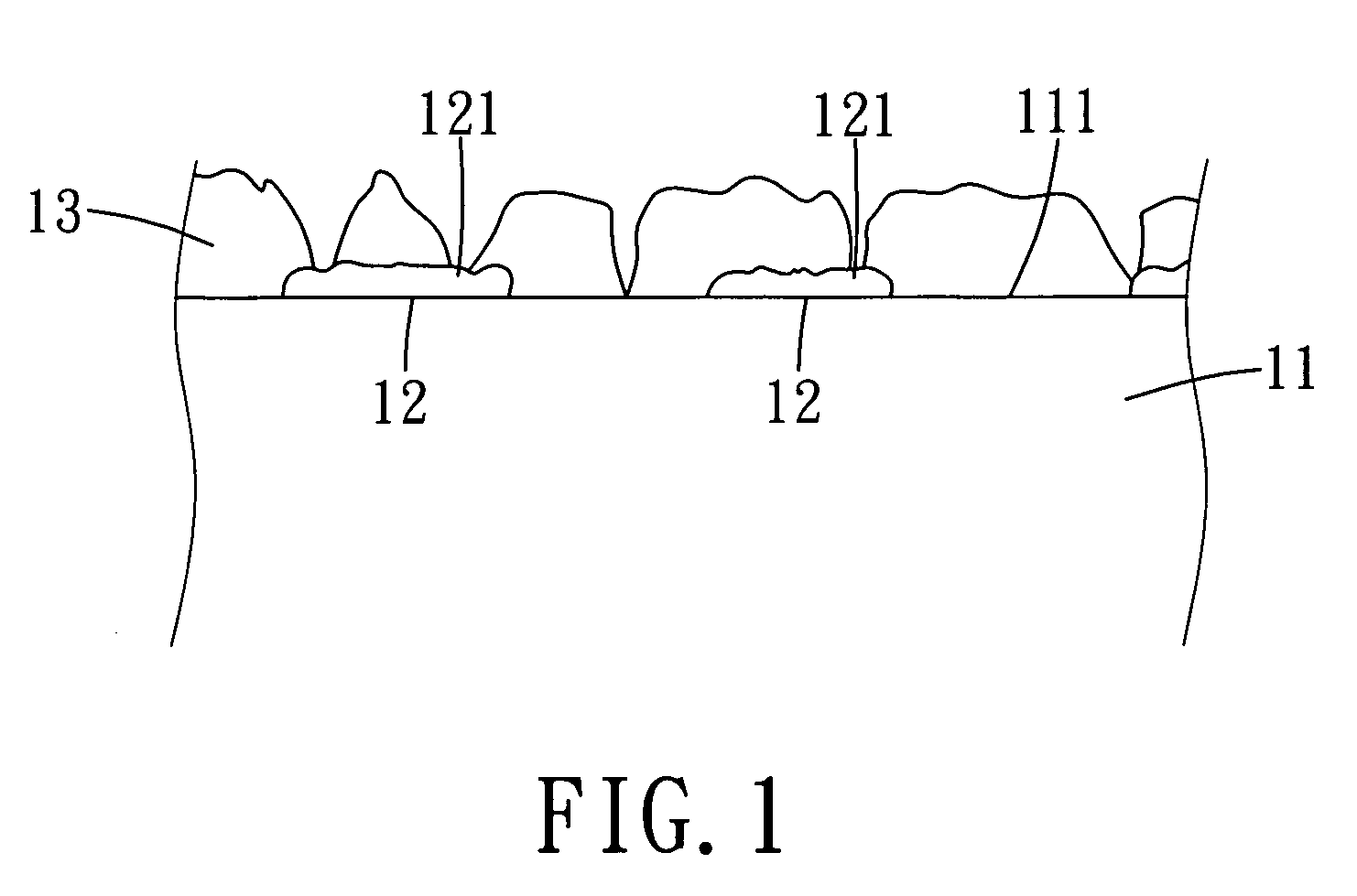Anti-microbial fabric and method for producing the same
a technology of anti-microbial fabric and anti-microbial fabric, which is applied in the field of anti-microbial fabric, can solve the problems of skin allergy and environmental problems, fabric color change, and easy to induce skin allergy and other problems
- Summary
- Abstract
- Description
- Claims
- Application Information
AI Technical Summary
Benefits of technology
Problems solved by technology
Method used
Image
Examples
example 1
[0031]A roll of 30 gsm melt-blown non-woven fabric 11 (white color) was set in a roll-to-roll type magnetron sputtering apparatus (not shown), and was transferred by drive motors (not shown) at a transferring speed of 12 m / min. The melt-blown non-woven fabric 11 was coated with 100 ppm silver clusters 12 by magnetron sputtering silver on an outer surface 111 of the non-woven fabric 11 under an argon gas working pressure of 2×10−3 torr, a power density of 0.3 w / cm2, and a sputtering rate of 12 m / min. The silver-coated non-woven fabric 11 was subsequently coated with titanium clusters 13 having an average thickness ranging from 100 to 150 Å by magnetron sputtering titanium on the outer surface 111 of the non-woven fabric 11 and on the silver clusters 12 under an argon gas working pressure of 2×10−3 torr, a power density of 5 w / cm2, and a sputtering rate of 12m / min. The titanium clusters 13 did not completely cover the silver clusters 12, so that parts 121 of the silver clusters 12 wer...
example 2
[0032]A roll of 50 Denier knitted polyester fabric 11 (light blue) was set in a roll-to-roll type magnetron sputtering apparatus (not shown), and was transferred by drive motors (not shown) at a transferring speed of 12 m / min. The polyester fabric 11 was coated with 100 ppm silver clusters 12 by magnetron sputtering silver on an outer surface 111 of the polyester fabric 11 under an argon gas working pressure of 3.75×10−3 torr, a power density of 0.3 w / cm2, and a sputtering rate of 12 m / min. The silver-coated polyester fabric 11 was subsequently coated with titanium clusters 13 having an average thickness ranging from 100 to 150 Å by magnetron sputtering titanium on the outer surface 111 of the polyester fabric 11 and on the silver clusters 12 under an argon gas working pressure of 3.75×10−3 torr, a power density of 5 w / cm2, and a sputtering rate of 12 m / min. The titanium clusters 13 did not completely cover the silver clusters 12, so that parts 121 of the silver clusters 12 were exp...
example 3
[0033]A roll of 30 gsm melt-blown non-woven fabric 11 (white color) was set in a roll-to-roll type magnetron sputtering apparatus (not shown), and was transferred by drive motors (not shown) at a transferring speed of 12 m / min. The melt-blown non-woven fabric 11 was coated with 300 ppm silver clusters 12 by magnetron sputtering silver on an outer surface 111 of the non-woven fabric 11 under an argon gas working pressure of 6×10−3 torr, a power density of 1.5 w / cm2, and a sputtering rate of 12 m / min. The silver-coated non-woven fabric 11 was subsequently coated with titanium clusters 13 having an average thickness ranging from 200 to 250 Å by magnetron sputtering titanium on the outer surface 111 of the non-woven fabric 11 and on the silver clusters 12 under an argon gas working pressure of 6×10−3 torr, a power density of 8 w / cm2, and a sputtering rate of 12 m / min. The titanium clusters 13 did not completely cover the silver clusters 12, so that parts 121 of the silver clusters 12 we...
PUM
| Property | Measurement | Unit |
|---|---|---|
| speed | aaaaa | aaaaa |
| incubating time | aaaaa | aaaaa |
| incubating time | aaaaa | aaaaa |
Abstract
Description
Claims
Application Information
 Login to View More
Login to View More - R&D
- Intellectual Property
- Life Sciences
- Materials
- Tech Scout
- Unparalleled Data Quality
- Higher Quality Content
- 60% Fewer Hallucinations
Browse by: Latest US Patents, China's latest patents, Technical Efficacy Thesaurus, Application Domain, Technology Topic, Popular Technical Reports.
© 2025 PatSnap. All rights reserved.Legal|Privacy policy|Modern Slavery Act Transparency Statement|Sitemap|About US| Contact US: help@patsnap.com


